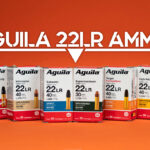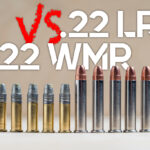
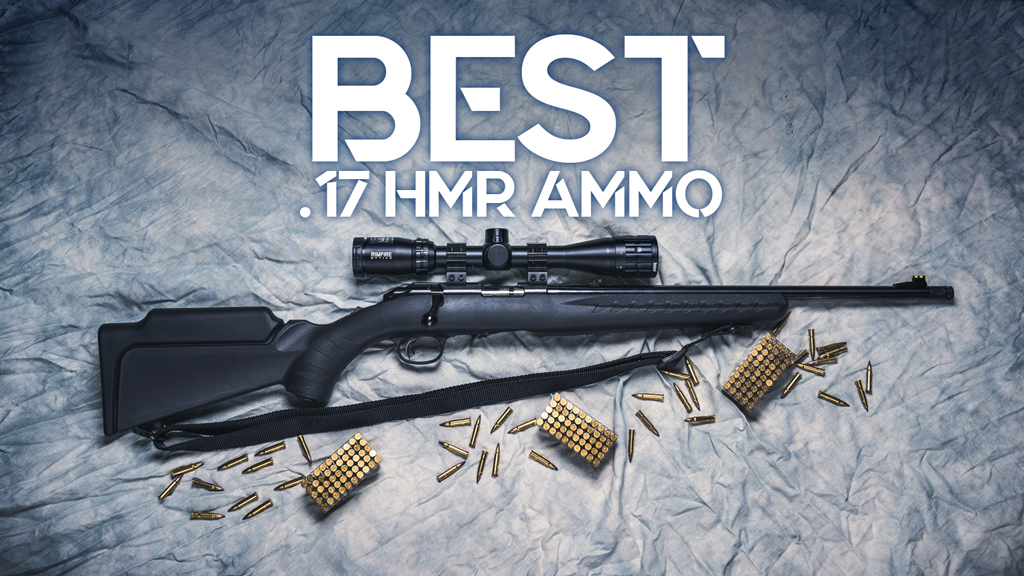
In this article, we delve into the world of the best .17 HMR ammo, exploring the best options available for various shooting needs, whether it’s for target practice or keeping your property free from unwelcome wildlife.
The .17 Hornady Magnum Rimfire (HMR) stands out as a remarkable innovation in the rimfire ammunition family. While it may be the runt of the litter, this capable little round has found its place among landowners across the nation as they deal with varmints who encroach on their property.
It excels in dealing with critters like prairie dogs and raccoons, making it a top choice for those seeking precision and power in a small package. Plus, it’s so quiet that it probably won’t even wake the neighbors.
A Little Rimfire History
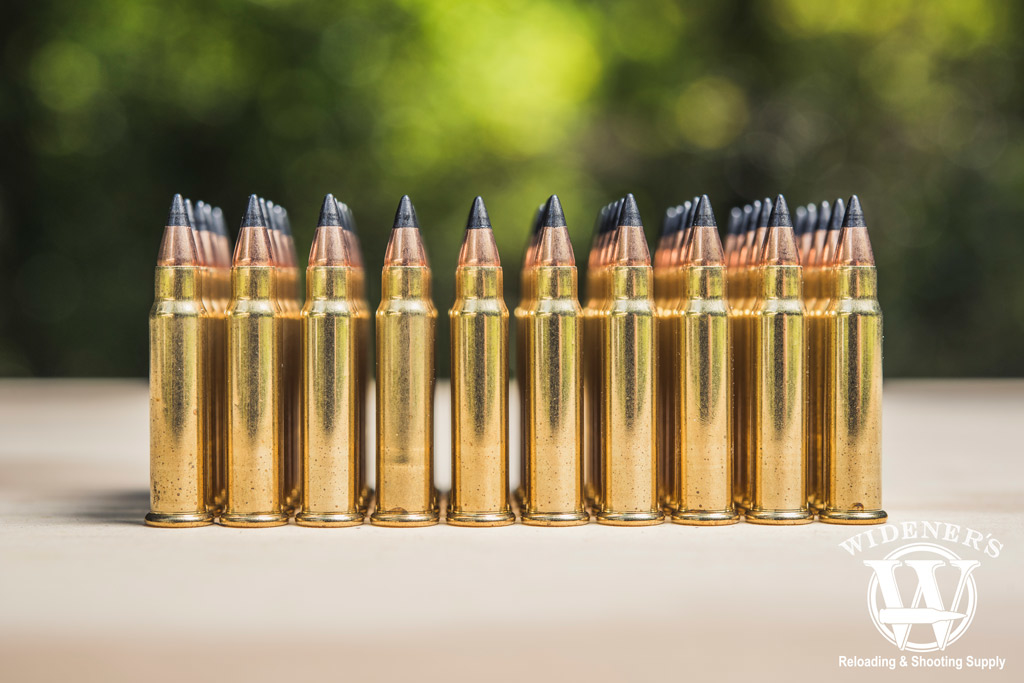
In 2002, Hornady created the .17 HMR rimfire cartridge by necking down a .22 Magnum casing.
Hornady answered the call of shooters who were seeking a high-velocity, flat-shooting round that could be used in platforms that are already popular with the .22 WMR. The .17 caliber projectile is extremely light, averaging only about 17-20 grains. However, they pack a real punch, cruising along at blistering paces of 2,300+ ft/s to nearly 2,700 ft/s. More significantly, these diminutive bullets carry a real thump for their size with muzzle energy ranging between 245 ft. lbs. and 250 ft. lbs.
Contrary to its little cousin, the .22 Short, which is the elder statesman of all metallic case cartridges, the .17 HMR is a rookie. Released to the market in 2002, the .17 HMR taps into the potential of an incredibly fast varmint round which would have better reach than any of the common .22 rimfire calibers and far flatter in trajectory. It also is able to use a regular .22 rimfire sound suppressor, offering a quiet option for taking varmints for considerably lower costs than a suppressed centerfire rifle.
The commonality of the .17 HMR with .22 WMR accessories and components is a tremendous virtue of the caliber. Common magazines are shared since they share a parent case, and the firearms are dimensionally identical between the two calibers.
Best 17 HMR Ammo
One really cool thing about using a .17 caliber bullet is that they are not a heeled bullet, meaning the bullet diameter is less than that of the case. This is in stark contrast to the .22 rimfires which are all heeled bullets. Why does this possibly matter? Well, having a heeled bullet limits just exactly what type and shape of bullet you can use. The .17 HMR is able to use bullet shapes familiar to centerfire shooters which are optimized for excellent ballistic ecoefficiency.
The bullets weigh in between 15.5 to 20-grains, depending on the type of bullet and intended application. Obviously, the lighter the bullet, the higher the velocity. Those little 15.5-grain bullets are some real screamers, boasting ballistic coefficients of around .115 and velocity of over 2,500 ft/s.
V-Max/V-Shok (Polymer Tip)
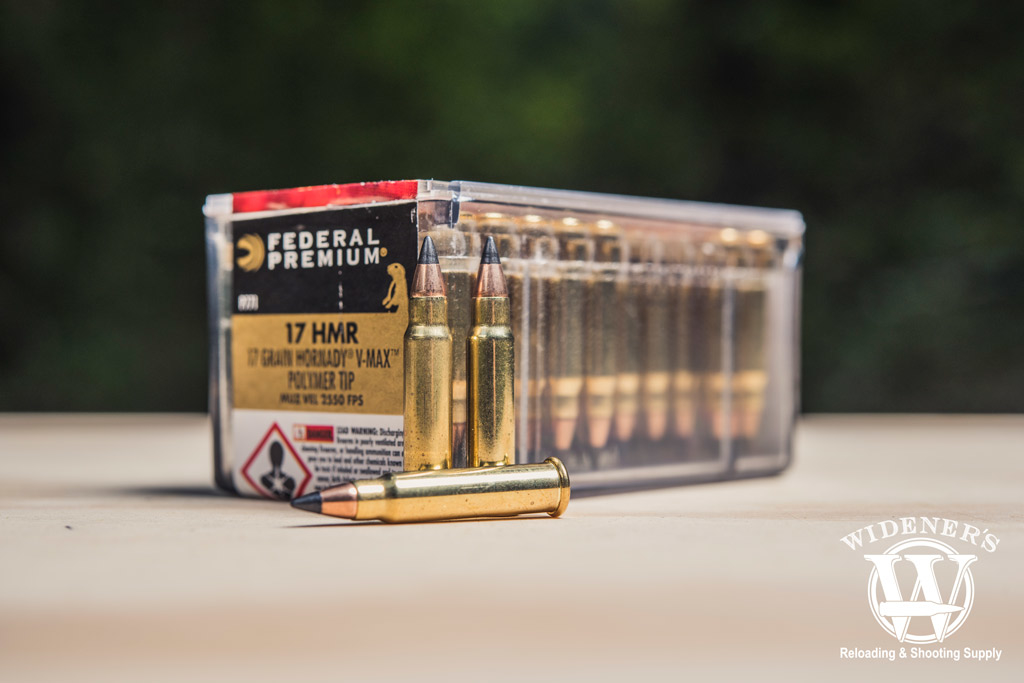
Federal Premium brand 17 HMR with HornadyV-Max bullets. The polymer-tipped V-Max has earned its reputation as a popular choice with varmint hunters.
Hornady V-Max is a serious contender in the ballistic world, you’ll find the popular poly-tipped bullet included in offerings from several different brands. Federal Premium 17 HMR includes the Hornady V-Max bullet in their V-Shok 17gr ammo to ensure maximum damage when hunting predators and vermin.
Designed to offer the devastating effect of a hollow point with the ballistic coefficient of an FMJ bullet, the V-Shok melds both worlds into an excellent projectile. While slightly heavier than its hyperactive younger brother(s) in the 15-16 grain weight class, the 17-grain V-Shok is absolutely no slouch running about 2,530 ft/s at the muzzle with a respectable 242 ft. lbs. of energy.
| Caliber | Bullet Type | Bullet Weight | Velocity (Muzzle) | Energy (Muzzle) | 100 Yards (Velocity/Energy) | 200 Yards (Velocity/Energy) |
|---|---|---|---|---|---|---|
| .17 HMR | V-Max (Polymer) | 17gr | 2,530 FPS | 242 FT LBS | 1,884 FPS/134 FT LBS | 1,360 FPS/70 FT LBS |
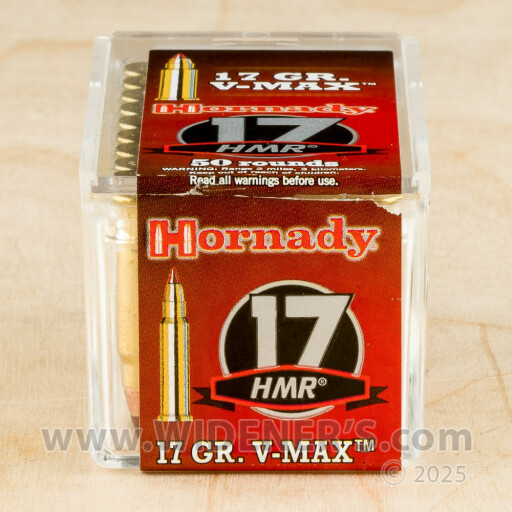
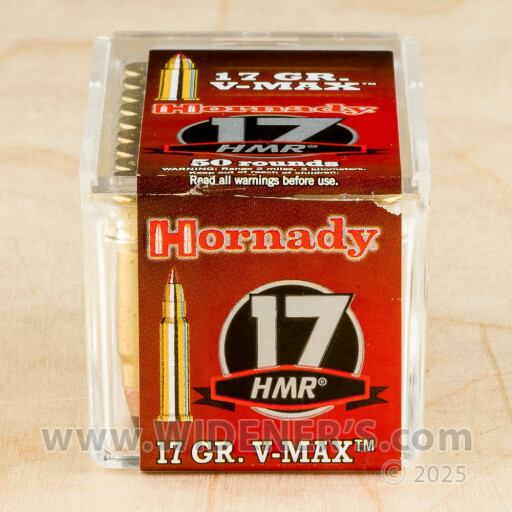
Jacketed Hollow Point
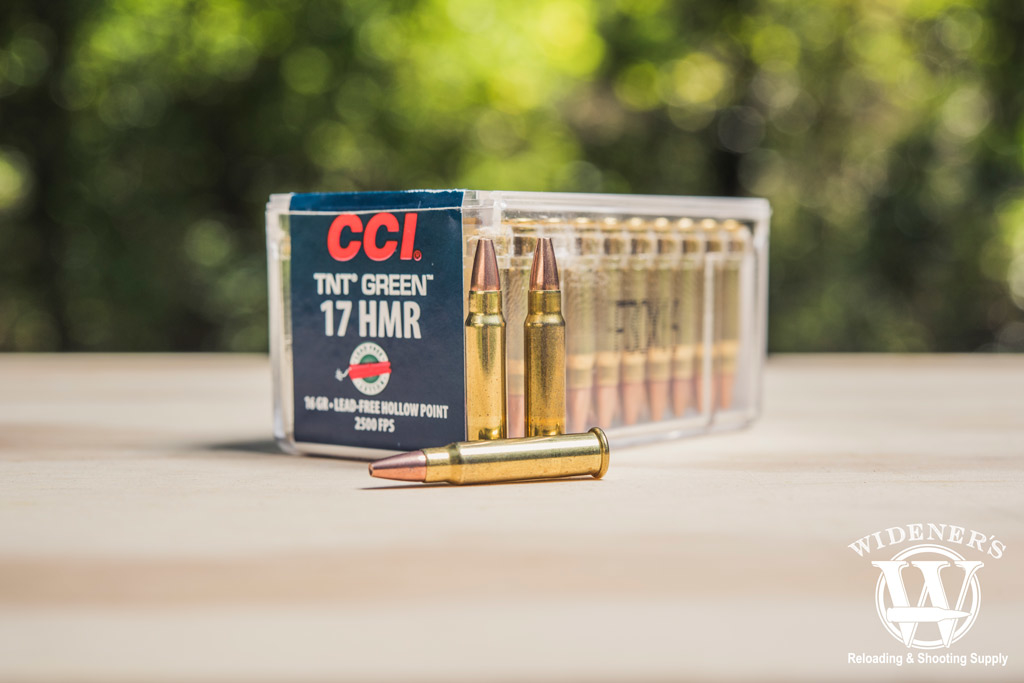
CCI’s 17 HMR jacketed hollow point is a very effective round for varmint hunting.
If the V-Max offers most of the characteristics of the hollow point, so why not use it all of the time? Good question. The big part of this equation is that a JHP Is lighter and in the case of .17 HMR ammo, that is a big deal.
V-Max bullets in .17 caliber weigh in at 17 grains, while a JHP is down around 16 or less. In this small of a bullet, that translates into a nearly 200 ft/s difference in velocity. Depending on your target, and what’s beyond it, the rapid fragmentation of the JHP may be the safest option.
The great benefit of an un-heeled rimfire bullet is that it acts exactly like an un-heeled bullet from any centerfire rifle. Hence, it expands like any centerfire bullet and does so with reliable consistency.
| Caliber | Bullet Type | Bullet Weight | Velocity (Muzzle) | Energy (Muzzle) | 100 Yards (Velocity/Energy) | 200 Yards (Velocity/Energy) |
|---|---|---|---|---|---|---|
| .17 HMR | Jacketed Hollow Point (JHP) | 16gr | 2,500 FPS | 222 FT LBS | 1,642 FPS/96 FT LBS | 1,242 FPS/55 FT LBS |
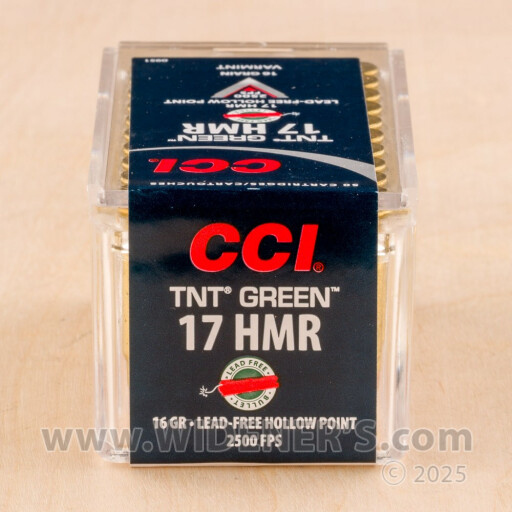
Full Metal Jacket
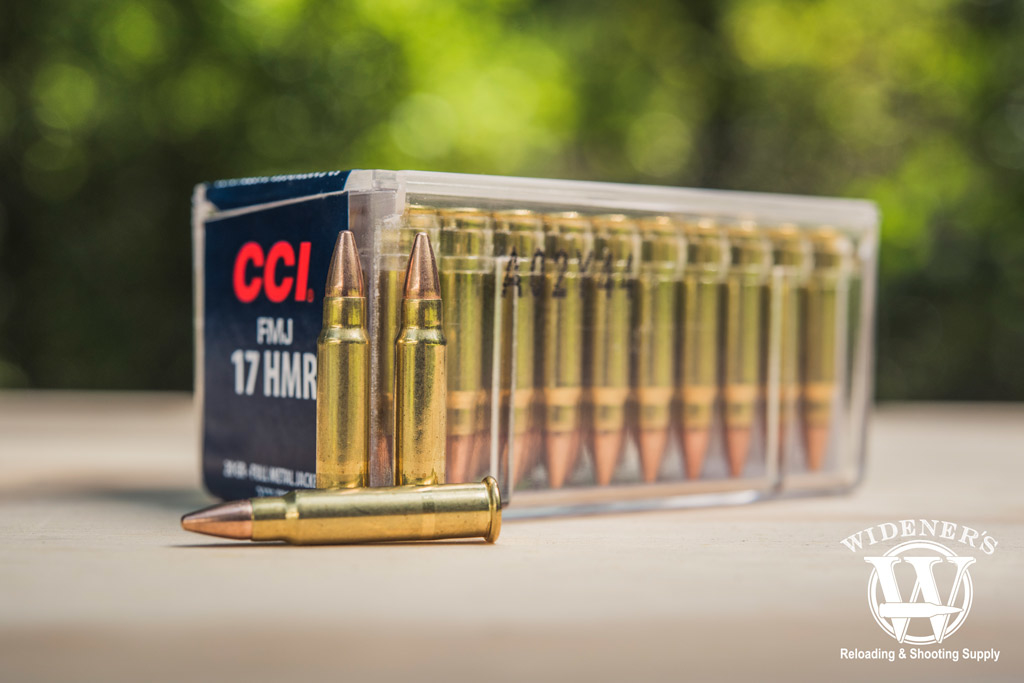
CCI also makes 17 HMR in the classic full metal jacket cartridge.
The traditional classic, not too much explanation is required of this stalwart bullet. Lead core, fully jacketed with copper. There is only one on the market. So options are somewhat limited in this respect, but it is manufactured by perhaps the most reputable rimfire ammunition manufacturer out there.
The FMJ offering looks for all the world like a scaled-down .223 and isn’t really a lot slower. It weighs in at 20 grains and exits the barrel at 2,375 ft/s, dropping down incrementally to 2,063 at 50 yards, 1.915 ft/s at 75, and 1,776 ft/s at 100. Energy is 250 ft. Lbs at the muzzle, dropping 189, 163, and 140 respectively.
This is going to be your go-to for weapon familiarization and zero, and also serves well to preserve meat in the event that you plan to eat your target or save the pelt. The V-Max and JHPs expand quite radically and will do substantial damage to the target.
| Caliber | Bullet Type | Bullet Weight | Velocity (Muzzle) | Energy (Muzzle) | 100 Yards (Velocity/Energy) | 200 Yards (Velocity/Energy) |
|---|---|---|---|---|---|---|
| .17 HMR | Full Metal Jacket (FMJ) | 20gr | 2,375 FPS | 250 FT LBS | 1,776 FPS/140 FT LBS | 1,260 FPS/70 FT LBS |
Effective Range Of The .17 HMR
The .17 HMR has a design with a superior trajectory to the common rimfires and an increased velocity. This leads to a more accurate round which is less susceptible to wind drift and suffers from considerably less drop. However, it does have limitations due to simple physics. A casing that small can only contain so much charge to push it fast for only so far.
Intended for a 100 yard zero, the saucy little bullet does its best work under 250 yards, and preferably at 200 or less. Drop at 150 yards is a respectable 3” -/+, and it can drop to nearly 10”-/+ at 200 yards. After that it really start to plummet, dropping to 22”-/+ at 250 yards, then -41”-/+ at 300 yards. Remember, this is still a diminutive little rimfire. However, it packs a lot of punch for what it is and at closer ranges. It packs a real thump on small animals at 100 yards or less. If you need more than that you should probably consider one of the very capable centerfire calibers.
Platforms for the .17 HMR
Based on the popular .22 WMR case and necked down to accommodate a non-heeled .17 caliber projectile, the .17 HMR is considerably larger than the .22 LR. Of course, these two aren’t really competing for quite the same title. It would be like comparing a Cavalier and a Corvette. Two distinctly different vehicles to do different things. One is economical, the other is a hot rod.
A bolt action is the most common platform for the .17 HMR with excellent offerings from several world-renowned manufacturers. Browning, Savage, Mossberg, Ruger and others all offer affordable bolt action rifles chambered in .17 HMR. There are even single-action Colt SAA replicas available by Chiappa in .17 HMR.
.17 HMR Quick Answer Box:
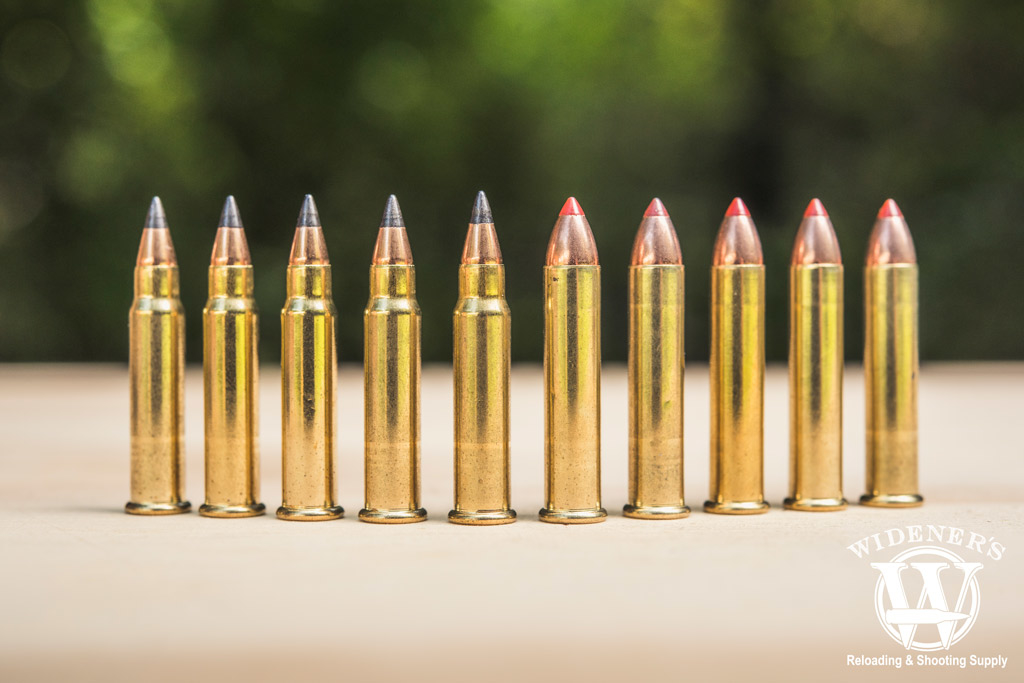
A side-by-side comparison of .17 HMR ammo (Left), and .22 Magnum ammo (Right).
• Are there semi-automatic rifle options for .17 HMR? Yes, there are several semi-automatic rifle options available for the 17 HMR. The Savage A17 and Volquartsen 17 HMR series rifles are among the most popular semi-automatic 17 HMR options.
• What is the effective range of a .17 HMR bullet? The effective range of a .17 HMR bullet for small game hunting and target shooting is about 150 yards. At 150 yards the .17 HMR cartridge experiences a bullet drop of about 3″-/+ which allows for consistent accuracy. It is possible with compensation to hit targets at 200 yards with the .17 HMR bullet, however, it experiences a bullet drop of 8″-/+ or greater at 200 yards making it difficult to achieve accuracy.
• Is .17 HMR bigger than .22LR ammo? The .17 HMR bullet is larger than the 22LR bullet by .349 inches. A .17 HMR bullet is 29% larger than the 22LR bullet. The .17 HMR bullet is a lighter grain-weight bullet than the 22LR.
What Is The Best .17 HMR Ammunition?
If you are in the market for a dedicated, highly accurate varmint caliber, look no further. When it comes to getting the job done, 17 HMR ammo is an excellent choice. You can drop any prowling critter under 50 pounds. It also shoots very flat out to around 200 yards and packs a real punch on impact.
It is available in the same type of non-heeled bullets as it’s much larger centerfire cousins such as the V-Max, jacketed hollow points, and full metal jackets. With a tremendous ballistic coefficient of only about .115, the 17 HMR shoots flat and straight. It’s largely unaffected by wind drift as long as it is used inside of its comfort zone of 150 yards or less.


